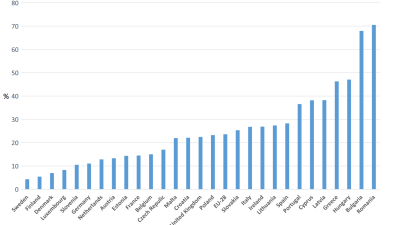Consistent poverty measure
A number of measures of poverty combine different approaches to poverty measurement, in particular income and deprivation measures, to provide what’s called a consistent poverty measure.
In the Republic of Ireland, for example, their anti-poverty strategy uses a consistent poverty measure that combines relative income with deprivation of one of eight basic necessities (see Chapter 5 Bare Necessities: Poverty and Social Exclusion in Northern Ireland).
The UK Child Poverty Act 2010 combines relatively low income with material deprivation. It set a target to reduce to less than 5 per cent the proportion of children who live in material deprivation and have a low income (Child Poverty Act 2010: A short guide).
The PSE studies have examined the overlap between the consensual method of measuring poverty and a relative income poverty threshold. See ‘The concept and measurement of poverty’ and Chapter 5 in Bare Necessities: Poverty and Social Exclusion in Northern Ireland.
Wider views of multi-dimensional poverty
Poverty has most commonly been measured primarily in terms of income and of material and social deprivation, including, more recently, measures of social exclusion. But increasingly poverty is seen as a more multi-dimensional concept incorporating aspects of, for example, psychological well being, such as mental health and shame. This wider, multi-dimensional view has, however, proved difficult to measure, in particular, in a way that allows for comparisons across time. In Coping with Complexity, child and adult poverty, Mark Tomlinson and Robert Walker examine the multi-dimensional nature of poverty and the possible use of structural equation modelling to create reliable indicators that capture this and, in Measuring Poverty in Britain as a Multi-dimensional Concept, 1991 to 2003, Mark Tomlinson, Robert Walker and Glenn Williams explore further its potential as a measure across time.
Capabilities-based poverty line
The idea of capabilities has been developed by Amartya Sen and is concerned with people’s abilities to lead the life that they not only value but have reason to value. This extends beyond income to other aspects of people’s lives. Amartya Sen outlines his capabilities-based approach to welfare on video at iTunes U (see track 3 for the video and track 4 for a transcript).
The problems with this approach have been to find ways to measure such a wide set of criteria. In Poverty, Capabilities and Measurement, Paul Anand, Christina Santos and Ron Smith (2008) set out an approach to tackling this problem and measuring capabilities.
A rights-based poverty line
How Poor is ‘Poor’? Towards a Rights-based Poverty Line is by David Woodward of the London-based New Economics Foundation. He proposes a rights-based poverty line, based on the level of income at which living standards consistent with economic and social rights are actually achieved in each country.
In June 2012, the International Labour Conference adopted a Recommendation that the right to social security is a human right. Recommendation 202 states that that all countries should provide a nationally defined minimum level of income security for its older citizens, for those of active age unable to earn sufficient income and for children. The Recommendation outlines 18 principles by which social security provision should be judged. In The indignity of the Welfare Reform Act, Robert Walker, Elaine Chase and Ivar Lødemel argue why the inclusion of dignity in the Recommendation's rights based approach matter to UK anti-poverty programmes.
Subjective measures of poverty
A number of studies have taken a subjective approach to poverty measurement, asking questions such as:
- Do they see themselves as being in poverty?
- Is their income below, or a lot below, what is needed or not?
In this approach people are asked to estimate minimum incomes to avoid ‘poverty’, though the exact wording of such questions varies considerably. Further details of how past PSE studies have used subjective poverty can be found in ‘The concept and measurement of poverty’ by David Gordon (pp. 51–2).
References
Anand, P., Santos, C. and Smith, R. (2008) Poverty, Capabilities and Measurement, Oxford, Oxford University Press.
Gordon, D. (2006) ‘The concept and measurement of poverty’ in Pantazis, C., Gordon, D. and Levitas, R. Poverty and Social Exclusion in Britain, Bristol, The Policy Press.
Hillyard P., Kelly, G., McLaughlin, E., Patsios, D. and Tomlinson, M. (2003) Bare Necessities: Poverty and Social Exclusion in Northern Ireland, Belfast, Democratic Dialogue.
Tomlinson, M., Walker, R. and Williams, G. (2008) Measuring Poverty as Multi-dimensional Concept, 1991 to 2003, Cambridge, Journal of Social Policy, 37, pp597-620.
Tomlinson M., Walker, R. and Williams, G, (2009), Coping with complexity, child and adult poverty, CPAG, London
Walker, R., Chase, E. and Lødemel, I. (2012), The indignity of the Welfare Reform Act, in Poverty, 142, CPAG, London
Woodward, D. (2010) How Poor is ‘Poor’? Towards a Rights-based Poverty Line, London, New Economics Foundation.
Last updated: 21 January, 2016



 PSE:UK is a major collaboration between the University of Bristol, Heriot-Watt University, The Open University, Queen's University Belfast, University of Glasgow and the University of York working with the National Centre for Social Research and the Northern Ireland Statistics and Research Agency. ESRC Grant RES-060-25-0052.
PSE:UK is a major collaboration between the University of Bristol, Heriot-Watt University, The Open University, Queen's University Belfast, University of Glasgow and the University of York working with the National Centre for Social Research and the Northern Ireland Statistics and Research Agency. ESRC Grant RES-060-25-0052.






